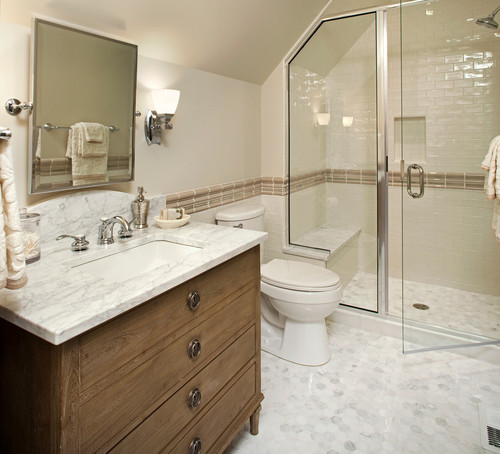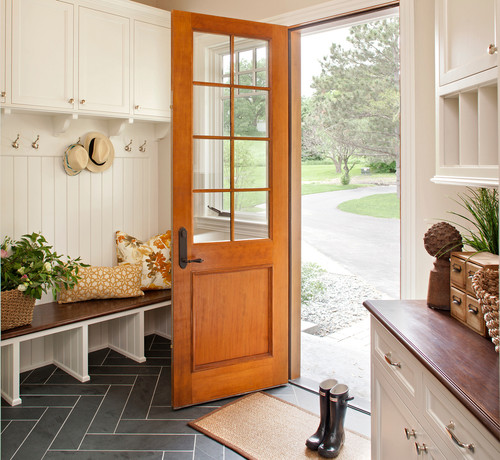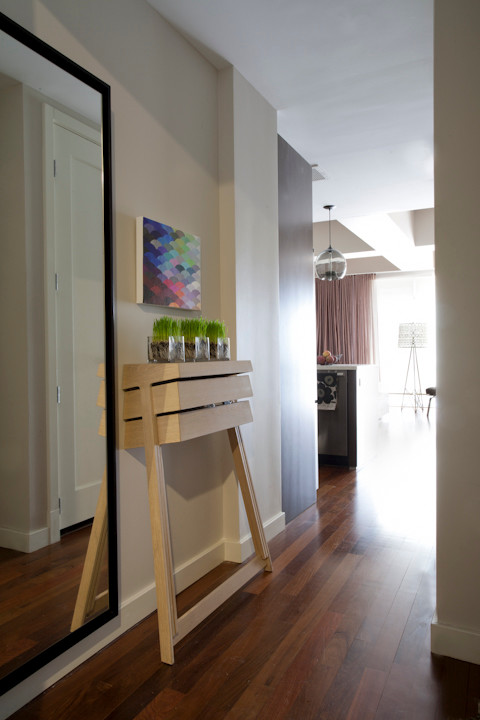Read all about Benjamin Moore Baby Fawn, plus see 15 real homes that use it!
Benjamin Moore Baby Fawn (OC-15, HC-173) is a balanced, warm-leaning greige paint that looks stunning in many homes.
What is greige? Well, it’s a blend between gray and beige. Some might call it the color of indecision (when you can’t choose between gray or beige), but I think of it as the color of ultimate versatility.
Greiges tend not to lean too strongly into gray or beige, so they play well with a greater variety of other colors and add depth to a room with changing lighting.
Let’s dive right into my latest paint color in this paint series. The goal of this series is to convey to you all the information you need about each shade to help you feel confident as you choose the next color that will adorn your walls.

What color is Baby Fawn?
Ok, there’s something I need to get out in the open here and now. Baby Fawn (OC-15) is the SAME color as Benjamin Moore’s popular Edgecomb Gray (HC-173).
Not only that, but Ben Moore has re-branded this same shade not just once, but TWICE as of the publication date of this article. Baby Fawn also goes by the name Alaskan Skies (Benjamin Moore 972) as well!
Why does Benjamin Moore have three names for the same color?
Well, to start, they have different codes after the name, which indicates they are part of different collections (OC = the off-white collection, and HC = the historical collection). Why the company felt it needed to give the same color multiple names is a bit of a mystery, except that it might be marketing-related.
Now that we’ve got that out of the way, Baby Fawn is a lovely, balanced, and versatile, creamy greige that can shift a bit depending on lighting and surrounding decor.
As part of the white color collection, it is one of the darkest of the white colors in that collection. However, it can wash out significantly in bright lighting, making it look more off-white than greige.

FAQs about Benjamin Moore Baby Fawn
What other colors are similar to Baby Fawn?
If you decide that you like Benjamin Moore Baby Fawn but really want something just a little different, here are some options.
Other terrific beige-leaning shades include Benjamin Moore Balboa Mist OC-27, Benjamin Moore Pale Oak, and Benjamin Moore Wind’s Breath.
Do you prefer something on the grayer side of the spectrum? In that case, Benjamin Moore Collingwood OC-28 is another mid-toned and balanced greige that doesn’t have any glaring undertones.
And Sherwin Williams Agreeable Gray is a popular and gorgeous mid-toned greige that many people turn to and love.
Is Benjamin Moore’s Baby Fawn warm or cool?
Overall, Baby Fawn is a very balanced color, but it does lean just a tad to the warm side. Basically, it won’t overwhelm you with warmth, AND it’ll keep that northern-lit room from feeling cold in the winter.
Where should I use Benjamin Moore Baby Fawn?
Short answer? Anywhere and everywhere!
The one caveat I would offer is that it can be tricky on kitchen cabinets due to the influence of so many surrounding elements (floor, counters, backsplash, etc.). BUT given the right lighting and decor, it can really make those cabinets shine!
Consider using this cozy, versatile, and flexible shade for any room in your house, including:
Entryways
Laundry rooms
Living rooms
Kitchens
Dining rooms
Bedrooms
Bathrooms
Basements
Exteriors
And more!
Baby Fawn is a neutral champ that can work well with any decor and house style!
If undertones make your head hurt, you’re not alone! Grab your free copy of 5 Biggest Paint Choice Mistakes Click here or enter your email below. I’ll send the tips right away!⤵️
Benjamin Moore Baby Fawn Undertones
Baby Fawn is one of the most neutral greiges that Benjamin Moore offers. While most greiges lean into green or pink undertones, this one has only the slightest hint of pink.
But that can be a double-edged sword. Because even though it doesn’t display strong undertones, that lack of commitment to an undertone means that it can pick up and display another. That’s why you’ll see Baby Fawn flash a hint of green from time to time.
Neither of these scenarios is obvious enough to think, “ew, why does my wall look green?”
If you find that you’re really noticing either pink or green undertones, there are a couple of reasons this might be happening:
- There’s a lot of green in your surrounding decor or coming through a nearby window.
- Your trim, accents, or furniture are cream – the yellow in cream can draw out the pink undertones.

How Different Types of Lighting Affect Benjamin Moore’s Baby Fawn
Natural light exposure shifts throughout the day as the sun moves through the sky. Thanks to this shifting light, don’t expect ANY paint color to look the same in two different areas or at different times of the day.
I have a secret weapon (okay, it’s not SO secret, but it IS important) to prevent you from choosing a paint color and HATING it once it’s covering your walls.
Use paint swatches (I love these peel-and-stick samples) to see EXACTLY how your lighting and decor will affect the way your paint looks. They’re a cinch to reposition and won’t damage your walls, but they WILL save you from headaches and wasted money!
Here’s a general idea of how Baby Fawn may appear based on different types of natural lighting.
- North-facing light – blue-tinted, cool northern light will pull out Baby Fawn’s gray side. It will tend to read cooler (with passive warmth) in northern lighting.
- South-facing light – warm yellow southern light will draw out those warm beige qualities and could allow a hint of pink to peek through.
- East-facing light – eastern light is warm and yellow in the morning and shadowy and blue-tinted in the afternoon. Baby Fawn will read warm, creamy greige in the morning before shifting to display its cooler gray face later in the day.
- West-facing light – expect shadowy light in the morning and ultra-warm light later in the day. Baby Fawn will start the day on a cooler note and shift toward its warm greige side (with a hint of pink) later in the day.

Great Coordinating Colors for Baby Fawn
One of the reasons I love Baby Fawn so much is because it’s a breeze to pair with many colors. You can feel confident using it around many whites, darker grays, corals, blues, and even some gray-greens.
If you need some specific color pairing ideas, check out these shades to safely pair with Benjamin Moore Baby Fawn:
- Seapearl
- White Dove
- Hale Navy
- Cloud Cover
- Abalone
- Kendall Charcoal
- Chantilly Lace
- Brentwood
- Metallic Gold
- Revere Pewter
- Dior Gray
- Gentleman’s Gray
- Oyster Shell
- Simply White
- Philipsburg Blue
- Chelsea Gray
- Gray Wisp
- Knoxville Gray
LRV of Benjamin Moore Baby Fawn (OC-15)
LRV is an abbreviation for “light reflective value.” Why does that number matter? It’s a helpful and objective way of measuring how much light is reflected (instead of absorbed) by a particular shade. In other words, it’s a simple and reliable indicator of how light or dark a shade will appear on your walls.
LRV ranges from 0 – 100. A color with an LRV of 0 is pure black. On the opposite end of the spectrum, an LRV of 100 is the brightest white you can imagine.
The LRV of Benjamin Moore Baby Fawn = 63.09

An LRV in this range indicates a shade that falls on the light side of medium darkness – or on the dark side of the light range. It kind of straddles both, making it easy to use in A LOT of spaces.
Baby Fawn has enough color and depth to contrast with white, even in bright lighting. It’s also light enough that it looks lovely (but not too dark) in rooms with low levels of light – like that dark hallway bathroom.
LRV…what? Don’t worry, I’ve got you! Grab a FREE copy of my new guide to avoid the paint color picking mistakes people make! Click here or enter your email below. I’ll send the tips right away!⤵️
Baby Fawn OC-15 Compared to Other Colors
I’m going to compare and contrast this shade with some other similar (and popular) paint colors to highlight the unique qualities of each shade. Here we go!
Benjamin Moore Baby Fawn vs. Pale Oak OC-20
To begin, let’s compare Baby Fawn to one of the most popular paint shades, Benjamin Moore Pale Oak (#OC-20).
A true greige, Pale Oak’s LRV of 69.89 puts it safely in the off-white category. Baby Fawn is just a smidge darker.
Both of these shades have a creamy quality, but Pale Oak has a bit of a purple undertone/slight pink hue that is more pronounced than what you’ll see in Baby Fawn.

Benjamin Moore Baby Fawn vs. Edgecomb Gray HC-173
In case you missed it above and just looked at Benjamin Moore Edgecomb Gray (#HC-173) side-by-side with Baby Fawn and thought, “they look REALLY similar,” you’re right! These two colors are actually the SAME color, but they are members of two different color collections and have two different names.
Confusing? I know, but they didn’t ask me my thoughts before coming up with these names, so I guess we just need to arm ourselves with knowledge.

Benjamin Moore OC-15 Baby Fawn vs. Alaskan Skies (Benjamin Moore 972)
Yet another Baby Fawn look-alike, Alaskan Skies is just another name for the same hue. Call it Edgecomb Gray, Alaskan Skies, or Baby Fawn…it’s the same beautiful Benjamin Moore warn neutral shade.

Benjamin Moore Baby Fawn vs. Revere Pewter
Benjamin Moore Revere Pewter (#HC-172) is another popular shade from Benjamin Moore. Its LRV of 55.51 makes this highly popular earthy, warm, and versatile greige read noticeably darker than Baby Fawn. In fact, I think it’s just too dark most of the time.
In addition, Revere Pewter’s noticeable beige and minimal green undertones combine to make this color appear taupe at times.

More Colors to Consider
Gah! Choosing gray and greige colors can be tough! If you just aren’t ready to hand over your hard-earned cash for cans of Baby Fawn, check out these other popular shades.
- Drift of Mist (Sherwin Williams) – a medium to light greige
- Silver Drop (Behr) – a pale gray with a hint of beige
- Accessible Beige (Sherwin Williams) – a popular beige that’s not too warm or dated
- On The Rocks (Benjamin Moore) – a mid-toned greige with a slight green undertone
- Repose Gray (Sherwin Williams) – is a warm-leaning gray-greige paint color
- Calm (Benjamin Moore) – a balanced light greige
- Worldly Gray (Sherwin Williams) – a popular mid-toned greige
- Shoreline (Benjamin Moore) – a light gray-leaning greige
- Anew Gray (Sherwin Williams) – a soft, light to medium warm greige
Feeling lost? I gotcha, boo! Grab a FREE copy of my new guide to avoid the paint color picking mistakes people make! Click here or enter your email below. I’ll send the tips right away!⤵️
15 Real Life Homes Using Benjamin Moore Baby Fawn
Okay, information overload is over! The information above is essential for giving you some background on Baby Fawn so that you know the basics. But many people find visualizing a shade in different settings just as helpful.
With that in mind, I found 15 real-life homes, rooms, and other spaces using Benjamin Moore Baby Fawn for you to see!
Living Spaces Painted Baby Fawn
1. Nice Complement to Brown Tones
In this living room from Satori Design for Living, you can see the chameleon tendencies of Baby Fawn. Notice the more beige tone on the left side of the image compared to the gray tones on the right side. Both sides are fantastically neutral!
2. Warm in Artificial Light
Jamie Snavley of InterDesign Studio via Houzz demonstrates the effect that artificial lighting can have on paint colors. Compare this image to the one above and notice how the warm artificial lighting pulls those beige undertones out in spades.
3. Casually Beautiful Off White
Baby Fawn walls next to white accents from @growing_upstate give us the chance to see just how light this shade appears. It’s clearly an off-white rather than a true greige.
4. Relaxed but Refined Hue
@poppy.style shows how lovely, elegant and refined this shade looks coupled with other neutrals as well as some respectable pops of color in this lovely living room.
BM Baby Fawn Bedrooms
5. Surprisingly Taupe in this Cozy Corner
The Marion House Book makes good use of red accents in the decor to draw out just a hint of that pink undertone I mentioned. Rather than being obvious, it’s just enough to make this room feel super cozy.
6. Nice and Light Contrast
I love this shade for rustic and farmhouse-style homes, like this example from Content + Company. Baby Fawn paired with white walls and dark wood ceiling beams: LOVE!
7. Perfect with a Pop of Color
Baby Fawn sets the perfect beige background for these colorful accent pieces from @poppy.style. The yellow and pink in the accent pieces draw out the beige (yellow base) of the color.
8. Warms up around Darker Tones
Extremely dark wood and black and feel cold or overwhelming at times. That’s not a problem for B Repurposed Design, who used Baby Fawn for the doors and trim to keep the space feeling light and welcoming!
Kitchens Using Benjamin Moore Baby Fawn
9. Clean and Modern Style
Remember how I mentioned that using Baby Fawn on cabinets can be tricky? Well, Blushing Boho Design expertly used it on these cabinets to tie the gorgeous backsplash and wood accents together.
10. Casual, Creamy Color for Kitchens
Satori Design for Living created a dreamy kitchen thanks to a little help from Baby Fawn. It has just enough saturation to contrast with white in a chic way.
Baby Fawn Paint in Bathrooms
11. A Light and Airy Powder Room
Baby Fawn is one of those shades that looks amazing with natural OR artificial lighting. Lively Green Door used it for this small bathroom, and it couldn’t look better!
12. Great for a Traditional Style
Baby Fawn is perfect for any style of home, and it looks both classic and projects understated sophistication in this bathroom from Vivid Interior Design (via Houzz | Builder: Hendel Homes | LandMark Photography).
Laundry Rooms Painted BM Baby Fawn
13. Beautiful on Trim, Doors, and Cabinets
Everyday Mamas used Baby Fawn as the accent color to contrast with the white walls. The end result is creamy taupe cabinets that look terrific.
Other Homes with Baby Fawn by Ben Moore
14. Inviting Mudroom Color Choice
Vivid Interior Design (via Houzz | Builder: Hendel Homes | LandMark Photography) shows us great contrast with a laundry room that has much more natural light. Here, instead of reading a taupe, Baby Fawn looks beige and a beautiful complement to the wood accents.
15. Perfectly Understated Entry
I love using Baby Fawn in small spaces like this entryway from Evelyn Lee Interiors (via Houzz | Photography: Beth Bates). It keeps the area feeling spacious, airy, and inviting.
So, what do you think? Isn’t Baby Fawn a gorgeous option? I hope you give it a closer look because it’s one of those shades that can make your home that stunning, comfortable space where you want to spend your time. Don’t forget to grab these easy peel and stick paint samples to check it out in real life before you spend $$ on it!
Pin this paint color for later! And if you use this paint shade, leave a comment on the pin! That helps others decide if they want to try this color, too!

Ready to show those boring, beige walls who’s the boss at home? Grab my free guide to help you sidestep the mistakes that almost everyone makes when it comes to picking paint! You’ll be on your way to perfect paint promptly…pinky swear.














Leave a Reply